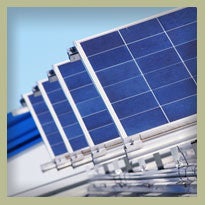Tapping into alternatives
 As institutions that operate year-long and 24 hours a day, it is no surprise that many hospital and health care providers have begun to evaluate on-site renewable energy projects. The benefits associated with the development of on-site "green" energy systems — solar photovoltaic systems, wind power systems and cogeneration facilities — include reduced energy costs, enhanced service reliability and a smaller carbon footprint.
As institutions that operate year-long and 24 hours a day, it is no surprise that many hospital and health care providers have begun to evaluate on-site renewable energy projects. The benefits associated with the development of on-site "green" energy systems — solar photovoltaic systems, wind power systems and cogeneration facilities — include reduced energy costs, enhanced service reliability and a smaller carbon footprint.
Facility managers also are discovering that renewable energy projects are supported by numerous government incentives and subsidies, some of which are available for a limited time or for a limited pool of projects. Because of this, hospitals and health care providers interested in renewable energy should move forward quickly to evaluate these projects.
Distributed energy benefits
Use of distributed generation, which refers to the generation of electricity from many small energy sources, has the potential to generate substantial cost and energy savings for hospitals.
One form of distributed energy is cogeneration, or combined heat and power (CHP). One cogeneration unit can capture 70 to 80 percent more of the British thermal units (BTU), or energy content, of an incoming natural gas than a typical utility-scale power plant, which may capture only 30 to 35 percent of the fuel's BTU value. The difference stems mainly from the fact that, with cogeneration, the waste heat is re-used rather than released into the environment. In November 2009, when New York-Presbyterian Hospital installed a 7.5-megawatt CHP facility, the hospital estimated that it would effectively eliminate 20,000 tons of air pollutants each year.
In addition to energy and subsequent cost savings, distributed energy provides another advantage for hospitals: a lessened dependence on the surrounding power grid. In the event of blackouts or brownouts, a hospital using a form of distributed energy — solar power, wind power or cogeneration — is able to meet its own requirements for electric power.
 |
| Wind projects often are eligible for certain types of tax incentives. |
Alternative financial structures
Solar, wind and cogeneration units can provide energy efficiency and independence, but facility managers often wonder how to build such projects cost-effectively. The answer: Direct ownership by the hospital or third party ownership, in which an independent service provider designs, builds and operates the renewable energy facility and sells its output to the hospital.
Under the direct ownership financial model, the hospital arranges for a third party to design and build the renewable energy facility. Under this approach, the hospital takes advantage of the tax incentives itself. Where applicable, the hospital also obtains and sells renewable energy certificates. This approach typically works more effectively for for-profit hospitals able to use the tax credits, grants and other tax incentives.
The main advantage of the direct ownership financial model is that the hospital retains full control of the facility. Additionally, there is no third party that must earn a reasonable return on its investment. This is particularly beneficial if the hospital has low-cost capital available.
A disadvantage of this approach is that the hospital bears some construction and operating risks. Also, a tax-exempt facility cannot take advantage of the federal income tax credit, direct grant or depreciation. If the facility does not operate as planned, the hospital must bear additional costs or lose a portion of the expected cost savings.
Under the third party ownership financial model, the hospital enters into either a power purchase agreement or an energy services agreement with a third party that designs, builds, owns and operates the facility. The hospital leases space to this third party and essentially agrees to purchase the full output of the facility, which may be either electricity alone or electric power, along with steam and chilled water.
One advantage of this approach is that the third party provider typically remains responsible for the operation and maintenance of the facility. The third party also may have engineering personnel with substantial operating expertise. Most of the construction and operating risks are imposed on the third party owner; thus, if the facility produces less power or less steam than expected, the hospital simply buys less and increases its purchases from other suppliers. This approach is often attractive for not-for-profit hospitals because a third party owner is able to exploit the tax incentives far more easily than a non-profit organization.
The main disadvantage of this approach is that the third party provider must be compensated appropriately for providing its own capital and for providing services on an ongoing basis. For cogeneration projects, the service provider may have to maintain a staff on site, and arrangements may be needed for joint use of certain facilities.
An issue that not-for-profit hospitals using this model may face is the effect an unrelated, for-profit company operating the renewable energy business has on the hospital's property. Many not-for-profit hospitals finance the construction of their original facilities from proceeds raised by issuing tax-exempt bonds. The tax code has very strict rules limiting the use of the proceeds to private projects. For example, a solar array on a not-for-profit hospital roof may run into these limitations, creating federal tax issues associated with the previously issued bonds. If the solar array owned by the private owner is considered to have broken this rule, the tax-free character of the original bond issue may be in jeopardy.
 |
| The tax incentives for solar photovoltaic systems are substantial. |
Tax incentives and subsidies
Now that you understand benefits of green energy and how to implement such a project, how can your health care facility take advantage of additional federal and state cost incentives? Capital costs for green energy projects can be paid partly by the federal government, by state agencies, and by ratepayers.
With respect to solar photovoltaic systems, the federal tax incentives available are substantial. Typically, either the hospital itself or a third party provider serving the hospital is able to obtain a 30 percent investment tax credit or grant in lieu of credit covering the cost of the equipment and its installation.
For the remainder of 2011, eligible construction projects have an objective safe harbor: if at least five percent of the costs have been incurred, the project owner may opt to receive a direct cash grant from the U.S. Treasury in lieu of the 30 percent investment tax credit. To do so, project owners must submit an application to the Treasury. A project that does not meet the safe harbor, however, may still be considered as a beginning construction in 2011 if the facts and circumstances warrant.
Not only does the federal government offer a 30 percent cost share—either in the form of the investment tax credit or a cash grant—but the project owner also is able to take advantage of accelerated depreciation. For eligible projects completed in 2011, the investment may be eligible for "bonus depreciation," in which the entire investment is depreciated over a single year, creating a current expense of all the eligible capitalized costs.
Wind projects often are eligible either for this tax credit or for a different tax incentive. A third party developer may build wind turbines on a hospital's facility and obtain a tax subsidy for every kilowatt hour of electric power sold to the hospital over a 10 year period. The credit is determined by multiplying 2.2 cents per kilowatt hour with the kilowatt hours of electricity that are (1) produced by the taxpayer from wind power facilities during a 10 year period and (2) sold by the taxpayer to an unrelated person during the taxable year.
In addition to federal tax cuts, many states offer direct grants and incentives for investments in renewable energy facilities, including sales tax exemptions and other tax breaks.
Many states also have adopted portfolio standards that require electric utilities and other retail power providers to utilize specified percentages of renewable energy. Under these programs, the owners of green energy facilities receive renewable energy certificates (RECs) for each megawatt hour of power produced per year. These RECs then may be sold on the open market, generating a revenue stream for the project owner.
An opportune time
Now marks an opportune time for hospitals and health care providers to evaluate the development of on-site renewable energy facilities. If properly structured, such projects can reduce operating costs, increase the reliability of electricity supply, and shrink a hospital's carbon footprint.
Marc D. Machlin and Todd B. Reinstein are partners at the law firm of Pepper Hamilton LLP. They can be contacted at machlinm@pepperlaw.com and reinsteint@pepperlaw.com, respectively.




